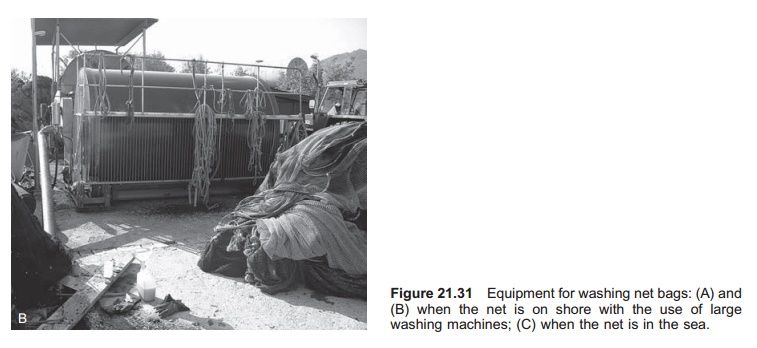Chapter: Aquaculture Engineering : Design and Construction of Aquaculture Facilities
Net handling - On growing production, sea cage farms
Net handling
Net handling
represents a major part of the total workload on a sea cage farm, and requires
additional equipment. For many sites fouling is a large problem for nets in the
sea and to reduce the degree of fouling the mesh size needs to be as large as
possible. This means that it is an advantage to change the nets according to
fish growth, so as large a mesh size as possible can be maintained. One or two
sizes are typically used per year, but this depends on growth and species; nets
can be much more frequently changed on exposed sites. Net exchange
is heavy work, especially on larger cages; large cranes are required to handle
the nets. This is also one reason for using subcontractors, because they have
large equipment specially adapted for the purpose.
If there is
much fouling on the site cleaning or washing of the nets is necessary. This
ensures enough water passes through the net panel to supply oxygen and remove
waste products. On exposed fouling sites, the nets need to be washed several
times a year, up to once a month. Washing may either be done when the net bags
are standing in the sea, or they can be removed and taken to shore for washing.
Special washing equipment is used by divers to wash nets in the sea. If the
nets are taken to shore, large washing machines are


used. These
machines are similar to a traditional domestic washing machine but have a
larger drum into which the nets are loaded (Fig. 21.31). The effluent from the
washing machines has a high content of fouling materials. This is discharged at
one place through the outlet pipe and the point outlet may be too high. Today
there are calls for purification of wastewater from such washing machines;
there is a particular problem with dis-charge of antifouling agents, because
normally at least 20% of the antifouling agents remain on the nets at the start
of the washing process.
The nets will
also need regular repair, because the mesh will break. This is normally done in
connection with washing and before the nets are set out again.
It is also
usual to treat the net with an antifouling agent to inhibit fouling so that
they can stay in the sea for longer before removal for washing. Copper-based
antifouling agents are widely used and quite effective. However, there are environ-mental
concerns regarding the use of copper, but no other antifouling agents have so
far achieved the same efficiency. Different types of biocides may be used, but
there are also environmental concerns
Related Topics